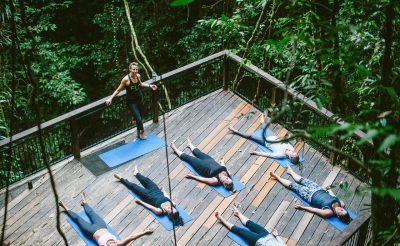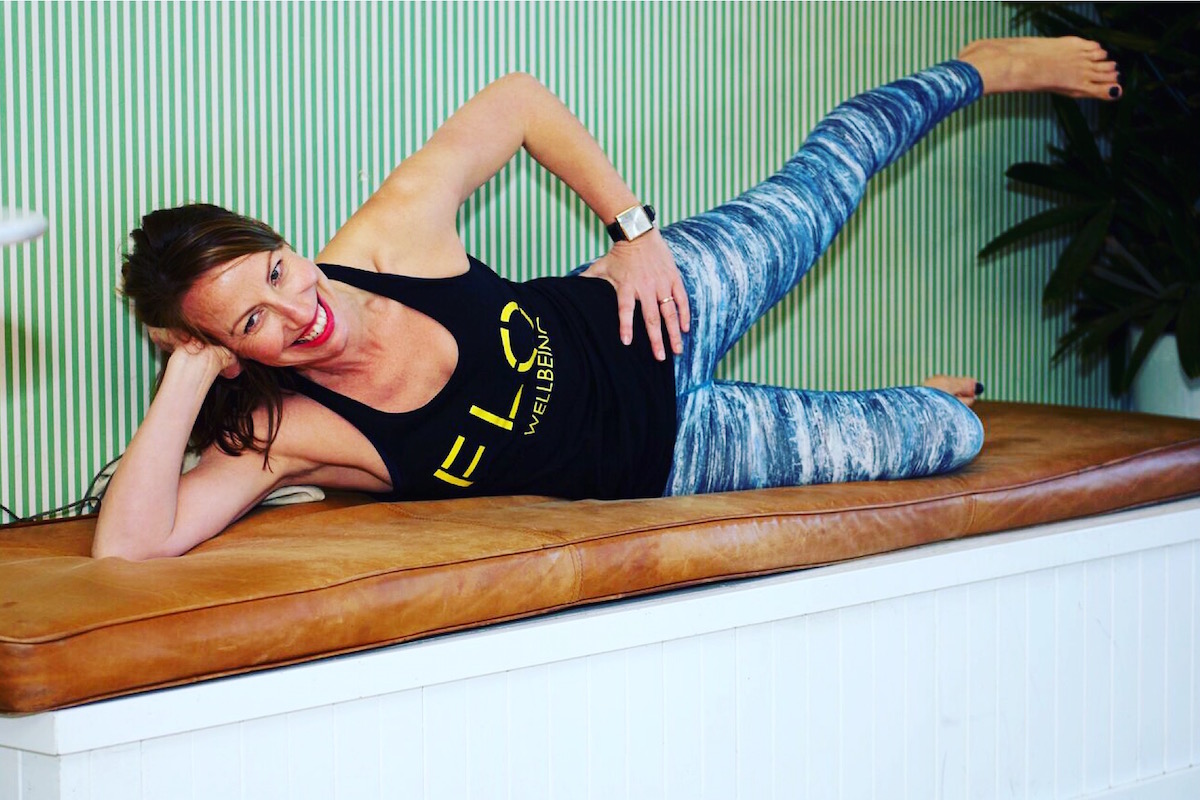Workout to avoid burnout

Arriving at Zen Collective for the start of our four-week Pilates and Mindfulness course with Flo Wellbeing, Founder Mandy Millan welcomes our group of 10 and we pad barefoot into a carpet-covered lounge room where we leave our personal belongings.
The venue on Sydney’s Northern Beaches is calm and welcoming and we have to resist settling on the lounges before we venture into the equally ambient studio.
Mats and straps are laid out ready for us on the carpeted floor, and after a brief introduction and obligatory health check, our lunchtime class starts with gentle stretches to unknot tight shoulders. We move through roll downs, cat stretches and leg raises to finish with a 10-minute mindfulness mediation.
A post shared by The CEO Magazine (@theceomagazineau) on
Used by many to strengthen and tone the body, Pilates is also an excellent way to relieve pain and stress while helping to improve posture. So, for office workers hunched over their desks for an average of 40 hours each week, the benefits of regular Pilates sessions are both mentally and physically rewarding.
A 2016 study published in The Lancet – the world’s leading independent general medical journal – estimates that physical inactivity costs healthcare systems and workplaces more than A$93 billion worldwide.
Rigid and repetitive desk work can lead to symptoms including:
- Carpal tunnel syndrome
- Lower back and neck pain
- Tension headaches
- Joint pain
- Stress
Rather than surfacing early on, these injuries often simmer below the surface until they result in serious back, neck or wrist problems.
However, with regular practice, Pilates can be used to increase spinal flexibility, strengthen the core, decrease stress and promote correct body posture – providing both immediate and long-lasting benefits. And a class can be done in your lunchtime.

Flo Wellbeing’s corporate wellness classes are 45 minutes to one hour long and, as a bonus, the exercises Mandy teaches can be easily applied to your everyday life outside of the studio.
Your brain will be clearer, your body looser and you’ll be able to do your job more effectively.
Flo Wellbeing’s daily practice tips
- Be here now
- Engage your core
- Stretch your spine
- Return to your breath
- Be in nature
- Hydrate
Mindfulness and mental health
To cap off our four-week course with Flo Wellbeing, our final session is dedicated solely to practicing mindfulness – focusing on our breathing and absorbing our physical surroundings.
Mandy hands over the reins to wellness coach Janette Dines – a lawyer and business executive who has firsthand experienced the benefits of a regular mindfulness practice.
Janette was the former CEO of the Royal Commission into Institutional Responses to Child Sexual Abuse between November 2012 and July 2014. Prior to that, she was Director-General of Emergency Management Australia, responsible for coordinating Australia’s response to natural disasters and national security incidents.
She began meditating in 2006 after experiencing panic attacks due to intense stress and anxiety at work. At first, meditating seemed like just another thing to add to her ‘to do’ list, but Janette was surprised to find she started to enjoy her practice and see real benefits.
Janette believes that meditation made her a more compassionate leader and mentor, empowering her to thrive in demanding jobs.
Janette leads Mindfulness Meditation for Flo Wellbeing. You can read more on her journey HERE.
Why be more mindful?
Buddhist monk and Nobel Peace Prize nominee Thich Nhat Hanh describes mindfulness as "the energy of being aware and awake to the present moment".
For an employee, this means thinking only of the task at hand and its purpose – not what is piling up in your inbox or what your colleagues might be gossiping about in the kitchen.
Once mainly associated with zenned-out ‘spiritual hippies’, the practice of mindfulness has now found its way into the offices of Google, General Mills, Target, Goldman Sachs and JP Morgan, all of which have introduced new ways for its staff to reduce stress through meditation, yoga and colouring-in books.
Thich Nhat Hanh describes mindfulness as "the energy of being aware and awake to the present moment".
Alternative medicine advocate, Deepak Chopra says: "Stress is the number one epidemic of our civilisation.
"Indirectly or directly, it’s related to things like insomnia, anxiety, fear, but [also] cardiovascular illness, inflammation in the body, heart disease, and autoimmune illnesses. So, meditation is a very effective way to start tackling this problem."
A report from the Australian Psychological Society indicates that one in four workers felt moderately to severely distressed , with 18 to 35 year olds reporting the highest stress levels.
Numerous studies have shown that when done properly and consistently over at least an eight-week period, mindfulness can retrain the mind, enable greater mental clarity, enhance memory and listening capacity, and ultimately discourage feelings of stress and anxiety.
And it’s easier than you think. Mindfulness can be practiced in any way you please, whether it’s for one minute or one hour, on your daily commute, during your lunchbreak or before bed.
All that matters is that you focus on clearing your mind and being present.
Here are some ways to encourage mindfulness in your workplace:
- Make time for mindfulness – aim for at least 20 minutes per day
- Focus on being less judgmental towards your co-workers
- Practice mindful breathing to restore your centre of calm
- Express gratitude
- Focus on one task at a time
- Email mindfully
Find out more about Flo Wellbeing’s Pilates and Mindfulness courses, and Corporate Retreats HERE.
OUR EXPERIENCES
Nyssa, 22, Senior Production Coordinator
WEEK 1
Had you done Pilates before? No, I hadn’t – only a few terms of beginner’s yoga, so I thought it would be similar.
Did you find it hard? No, I didn’t find it terribly hard. I’ve always had a fairly strong core, due to ballet training. My flexibility is definitely nowhere near what it used to be, which made some parts of the class more challenging than others.
How did you feel afterwards? Immediately after the class I felt fresh, relaxed and invigorated. I felt strong. The next day I was definitely feeling my muscles. My lower back and shoulders were aching – but I guess that just means the exercises worked!
Would you do it again? I most definitely would do it again – I’m looking forward to next week!
WEEK 4
Have you enjoyed the course? Yep! I’ve found it to be a great break in the middle of work day, which is much needed sometimes. After each class I feel more focused and switched on, as well as relaxed and calm. I’ve found that each week there’s a new challenge to work on and it’s really helped me to listen to those parts of my body that need some work.
Do you feel any different? I do actually! At the gym last night, I was just thinking, ‘My core is definitely more solid than usual’. I managed to complete core exercises at the gym I’ve been struggling through, which is a great feeling. Not only that my sense of balance seems to be improving as well. I think I’m becoming more in tune with my core, and activating it more often than before I started the course.
Will you carry on with Pilates? I will definitely carry on with it; I feel like it’s the best type of exercise for my body!
What have your learned? I’ve learned to be more open. After school and uni, I had some pretty terrible shoulder problems that were attributed to bad posture – being huddled over books and computers. The shoulder exercises we’ve been working on in class have been really good for stretching out those problem areas that so often get sore. I’d like to continue with the breathing and meditation exercises to help with my stress levels and sleep patterns.
Keelan, 28, Graphic Designer
WEEK 1
Had you done Pilates before? No, it was my first time.
Did you find it hard? It was harder than I thought it would be. It was challenging, which made it worth going.
How did you feel afterwards? I felt like I had more energy than usual at the end of the day. The next day when I got up from my desk to get something, everything hurt.
Would you do it again? I would definitely do it again.
WEEK 4
Have you enjoyed the course? Yes, I have really enjoyed it, and having a proper break in the middle of the day.
Do you feel any different? I have less back pain; I feel mentally clearer, too.
Will you carry on with Pilates? I may carry on with it, if I have time to fit it into my regular exercise routine.
What have your learned? I’m more aware of my posture and balance, and I think both have improved.
Skye, 26, Assistant Editor
WEEK 1
Had you done Pilates before? I’d tried it once or twice but never stuck with it consistently to notice any changes.
Did you find it hard? It wasn’t too difficult. I could certainly feel some muscles working that I hadn’t used in a while but it was still manageable. The hour went quickly and the final meditation was a lovely way to end the class.
How did you feel afterwards? I felt energised and ready to tackle the second half of the day. My mood also lifted.
Would you do it again? Definitely. It was a great way to break up the work day. I returned to the office feeling refreshed and wide awake. I also felt I was more productive than I’d typically be in the afternoon.
WEEK 4
Have you enjoyed the course? It’s been fantastic. It’s been a great opportunity to add discover some new moves, add some mindfulness into my day and reverse the effects of sitting at a desk in a busy office all day.
Do you feel any different? The effects for me have been more immediate than long-term at this stage. Once I get back into the office directly after a class I feel more relaxed and refreshed. My brain is ready and raring for the second half of the day. I’m sure the longer-term effects will come after keeping it up for a couple of months.
Will you carry on with Pilates? I’d like to, yes.
What have your learned? To be more conscious of my posture while sitting at my desk.